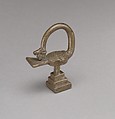Gold Weight: Bird (Sankofa)
Not on view
Beginning in the fourteenth century, the Akan engaged in extensive trade with both the Portuguese and Spanish along the west coast of Africa, which subsequently came to be known as the "Gold Coast." The Akan used differing and complicated systems of measurement for trade with European and Islamic traders. In Akan society, gold was intimately associated with authority, royalty, and the sacred. Its lavish use in regalia and ornament was a prominent feature of Akan court ceremony. These three gold weights reflect the wealth and breadth of Akan metallurgic virtuosity and take the form of a chair, a bird with its head turned back to its tail, known as Sankofa, and a chicken head.
In Akan society, a great deal of importance is placed on verbal eloquence and the artful interpretation of proverbs in expression. Proverbs are the source of imagery for many forms of Akan visual art, including gold weights. The Sankofa image is derived from the Akan proverb that states, "There is nothing wrong with learning from hindsight." The motif may be based on a mythical bird that flies forwards with its head turned backwards, or it may be based on a bird that reaches behind it for food. In Akan proverbs, the hen is frequently associated with the wisdom of elders. The Akonkromfi chair, with x-form legs, was primarily used on festive occasions and most likely modeled after a European folding-chair prototype popular in the seventeenth century. Stools and, by association, chairs are the primary components of Akan royal regalia. The most famous Akan stool is the Asante Golden Stool, which is said to have descended from heaven and to have been solid gold.
This image cannot be enlarged, viewed at full screen, or downloaded.

